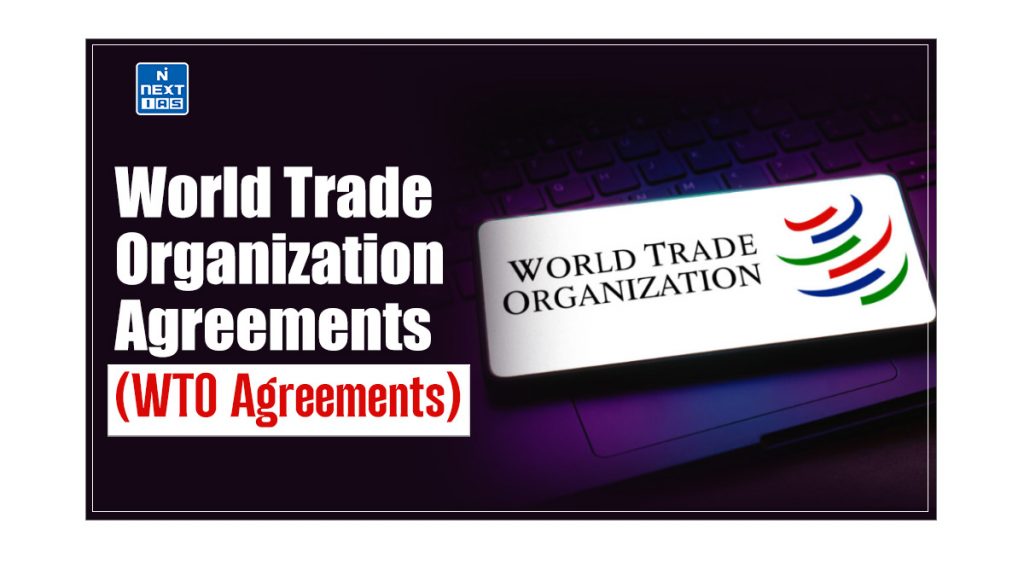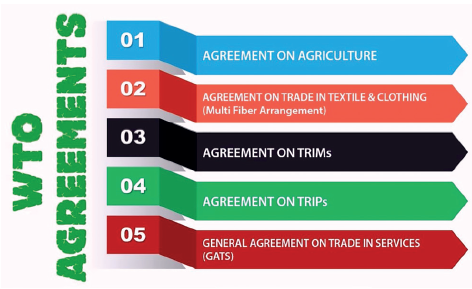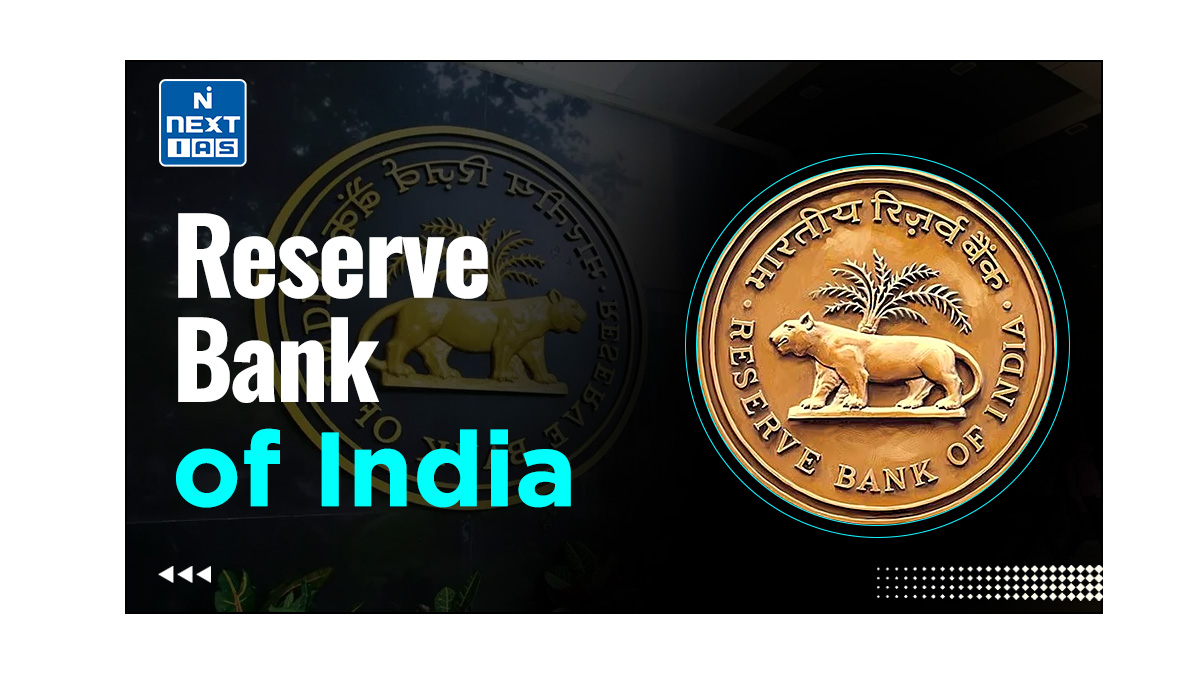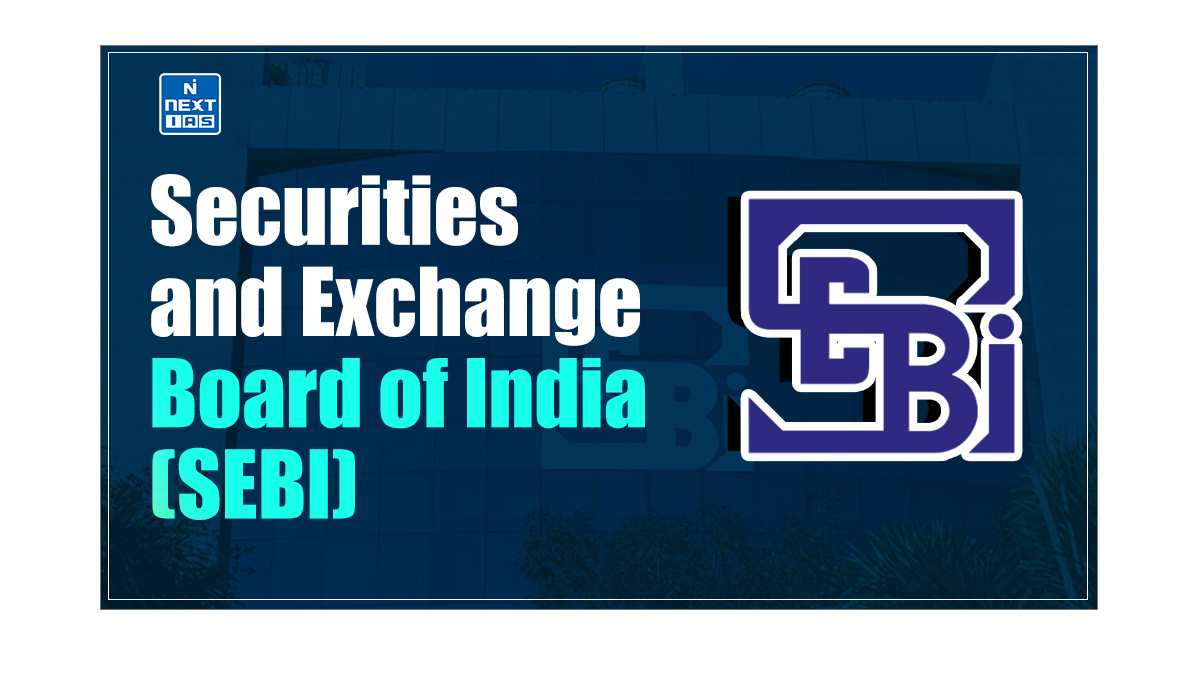
The World Trade Organization Agreements (WTO Agreements) lie at the heart of the regulation of global trade. These agreements, together, ensure that trade flows as smoothly, predictably, and freely as possible. This article aims to study in detail the World Trade Organization Agreements (WTO Agreements), including the Agreement on Agriculture (AoA), Trade Related Intellectual Property Rights (TRIPS), Sanitary and Phyto-Sanitary Measures (SPS), General Agreement on Trade in Services (GATS), Agreement on Trade Related Investment Measures (TRIMS), and Agreement on Subsidies and Countervailing Measures (SCM).
What are World Trade Organization Agreements (WTO Agreements)?
- The World Trade Organization Agreements (WTO Agreements) refer to a set of international trade rules and commitments negotiated and signed by the member countries of the World Trade Organization (WTO).
- These agreements form the legal foundation for global trade and are designed to promote fair competition, reduce trade barriers, and facilitate smooth and predictable international commerce.
- The agreements cover a wide range of areas, including trade in goods, services, and intellectual property rights, and they establish the framework for resolving trade disputes among members.
- Overall, the WTO oversees about 60 different agreements, all of which have the status of international legal texts.
- Some of the most important World Trade Organization Agreements (WTO Agreements) include:
- Agreement on Agriculture (AoA),
- Trade Related Intellectual Property Rights (TRIPS),
- Sanitary and Phyto-Sanitary Measures (SPS),
- General Agreement on Trade in Services (GATS),
- Agreement on Trade Related Investment Measures (TRIMS), and
- Agreement on Subsidies and Countervailing Measures (SCM).

Each of these World Trade Organization Agreements (WTO Agreements) has been discussed in the sections that follow.
| About World Trade Organization (WTO) – World Trade Organization (WTO) is a global multilateral organization established in 1995 for the rules-based trading between the nations of the world. – It is a global membership group that promotes and manages free trade. – It serves as a forum for governments to negotiate trade agreements and settle trade disputes. Read our detailed article on the World Trade Organization (WTO). |
WTO Agreement on Agriculture (WTO AoA)
- The WTO Agreement on Agriculture (AoA) was negotiated during the Uruguay Round of the General Agreement on Tariffs and Trade (GATT).
- WTO AoA entered into force with establishment of the World Trade Organisation (WTO) on January 1, 1995.
- Its objective is to reform agricultural trade by creating a fair and market-oriented system, enhancing stability and predictability for both importing and exporting nations.
- The WTO Agreement on Agriculture applies to the following categories of agricultural goods:
- Basic agricultural products (such as wheat and live animals),
- Products derived from basic agricultural products (such as flour and meat), and
- Most of the processed agricultural products (e.g. chocolate and sausages),
- Wines, spirits, and tobacco products, and
- Fibers (such as cotton).
Three Pillars of WTO Agreement on Agriculture
The WTO Agreement on Agriculture (WTO AoA) has three pillars – Market Access, Export Competition, and Domestic Support.
Market Access
Market Access requires that tariffs (like custom duties) fixed by individual countries be cut progressively to allow free trade.
It also requires countries to remove non-tariff barriers and convert them to Tariff duties.
Export Competition
- Export subsidies are presumed to have trade-distorting effects.
- They allow exporters, who benefited from such subsidies, to sell below the cost of production.
- In that way, export subsidies reduce world prices undercutting exporters in other countries.
- Each Member undertakes not to provide export subsidies other than in conformity with this Agreement and with the commitments specified in that Member’s Schedule.
Domestic Support
- This pillar is based on the assumption that not all subsidies distort trade to the same extent.
- Accordingly, it puts domestic support into two categories – Green Box and Amber Box.
Green Box
- It includes supports with no or minimal distortive effect on trade.
- For example, government-provided agricultural research or training.
Amber Box
- It includes trade-distorting supports.
- For example, government buying-in at a guaranteed price (“market price support”).
WTO Boxes
- The WTO identifies subsidies by “boxes” which are given the colors of traffic lights.
- Different WTO Boxes of Subsidies are described below.
Amber Box
- Domestic support measures that distort production and trade (except for those contained in the Blue and Green Boxes) are kept into the Amber Box.
- They include measures which are aimed to support prices or subsidies which are directly related to production quantities.
De Minimis
- De Minimis provision allows developed countries to maintain trade-distorting subsidies or ‘Amber box’ subsidies to the level of 5% of the total value of agricultural output.
- For developing countries, this figure is 10%.
Blue Box
- This is the “amber box with conditions”.
- The conditions so attached with this box are designed to reduce distortion.
- Any support that would typically fall under the Amber Box is categorized into the Blue Box if it also requires farmers to limit production.
- At present, no limits have been placed on spending on blue box subsidies.
Green Box
- Subsidies that do not distort trade, or at the most, cause minimal distortion are placed under Green Box.
- These subsidies are allowed without limits.
- They have to be government-funded and must not involve price support.
- It includes programs that are not targeted at particular products, direct income supports to farmers that are not related to current production levels or prices, environmental protection programs, agricultural research and development subsidies, etc.
Development Box or S&D Box
- Article 6.2 of the Agriculture Agreement (AoA) allows the developing countries additional flexibility in providing domestic support.
- The type of support that falls into the developmental category include the measures of assistance, whether direct or indirect, which are designed to encourage agricultural and rural development and are an integral part of the developmental programs of developing countries.
- They include agricultural input subsidies generally available to resource-poor or low-income producers in developing countries, and domestic support to producers in developing countries to encourage diversification from growing illicit narcotic crops.
Trade Related Intellectual Property Rights
What is Intellectual Property (IP)?
- Intellectual Property (IP) refers to intangible creations of the human intellect.
- Artistic works like literature and music, as well as some discoveries, inventions, phrases, words, designs, and symbols, can all be protected as intellectual property.
What is Intellectual Property Right (IPR)?
Intellectual Property Right (IPR) refers to the legal right that protect creations of the mind, such as literary and artistic works, inventions, designs, and symbols, names, and images used in commerce.
Types of Intellectual Property Rights (IPRs)
Patent
- A Patent is a legal document that grants an inventor the exclusive right to make, use, and sell an invention for a specified number of years.
- A patent gives the patent-holder an exclusive right to prevent others from making, using and selling the patented invention for a certain period (typically 20 years from the filing date).
- In India regulated under Patents Act 1970, (Amended in 2006).
- Period – typically 20 years from the filing date.
Copyright
- A copyright protects the expression of literary or artistic work.
- It gives the copyright-holder the exclusive right to control reproduction or adaptation of such a work.
- In India regulated under the Copyright Act 1975, (Amended in 2012).
- Period – 60 years.
Trademarks
- A trademark is a distinctive sign which distinguishes the products or services of one business from that of others.
- Trademarks are often closely linked to brands.
- In India regulated under the Trademark Act 1999.
- Period – 10 years.
Industrial Design
- Industrial Design is a type of Intellectual Property Right (IPR) that gives the holder an exclusive right to make, use and sell articles that embody the protected design, to selected people only.
- Protection rights are provided for a period of 10 years.
- In India regulated under the Designs Act 2000.
Trade Secrets
- A trade secret refers to any formula, process, practice, design, or compilation of information that is used by a business to obtain an advantage over its competitors.
- As the name suggests, Trade Secrets are not disclosed to the world at large. Eg. the composition formula of Maggi or Pepsi.
Geographical Indication
- A Geographical Indication (GI) is a sign used on products that have a specific geographical origin and possess qualities or a reputation that are due to that origin.
- In order to function as a Geographical Indication (GI), a sign must identify a product as originating from a specific place.
- Additionaly, the characteristics, qualities, or reputation of the product must be essentially due to the place of origin. For Eg. Banarasi Saree, Darjeeling Tea, etc.
- These rights are generally enjoyed by a community rather than individuals only.
- In India regulated under the Geographical Indication of Goods (Registration and Protection) Act 1999.
- Period – 10 years.
WTO Agreement on TRIPS
- The WTO seeks to establish an appropriate framework for the protection of intellectual property rights (IPRs) in order to bring greater order to international trade.
- With the same objective, a consensus was developed on the TRIPS Agreement in Marrakesh in April 1994.
- TRIPS Agreement took effect on 1 January 1995.
- Some of the salient points of agreement are:
- It establishes minimum standards for the regulation of many forms of Intellectual Properties (IPs) by national governments, as applied to nationals of other WTO member nations.
- It covers all legally recognized intellectual property rights, including patents, copyright and related rights, geographical indications, trademarks, industrial designs, layout designs of integrated circuits, and undisclosed information.
- It incorporates and improves upon protection levels of the earlier frameworks like Paris Convention (for industrial property rights) and the Berne Convention (for copyrights).
- Developed countries were given a transition period of one year from the date of entry into force of the WTO TRIPS Agreement; developing countries and transformation countries were given five years (i.e. until January 2000); and Least Developed Countries were given 11 years (until January 2006).
- The transition period for the Least Developed Countries (LDCs) to implement TRIPS was further extended to 2013, and until 1st January 2016 for pharmaceutical patents, with the possibility of further extensions.
Flexibilities under TRIPS
Compulsory Licensing
- Compulsory licensing is when a government allows someone else to produce the patented process or product, without the consent of the patent owner.
- Compulsory licensing and government use of a patent without the authorization of its owner can be done only under some specific conditions, such as national emergencies and other circumstances of extreme urgency etc.
Parallel Importing
- It refers to marketing the products by the patent owner (or trademark or copyright-owner, etc.) or with the patent owner’s permission in one country and importing into another country without the approval of the patent owner.
- The products are indeed legal but are unauthorized as they are imported without the permission of the Proprietor.
TRIPS Plus
- TRIPS Plus is the term denoted to a higher level of Intellectual Property protection norms demanded by some of the developed countries, but are not prescribed by the WTO’s TRIPS regime yet.
- Developed countries are putting pressure on the developing countries who are becoming members of FTAs to enact these tougher conditions in their domestic patent laws.
- One prominent example of emerging TRIPS plus norms is Data exclusivity. It is basically the protection of clinical test data which is submitted to a regulatory agency in order to prove the safety, quality, and efficacy of a new drug to be introduced, and also preventing the generic drug manufacturers from relying on this data for utilizing in their own applications.
Sanitary and Phyto-Sanitary Measures (SPS)
- The Sanitary and Phytosanitary Measures (the ‘SPS Agreement’) was incorporated into the World Trade Organization on 1 January 1995.
- It is concerned with the application of food safety, and animal and plant health regulations in cross-border trade of biological goods.
- As a part of SPS, all nations undertake measures to ensure that food products are safe for consumers and also to prevent the spread of diseases or pests among animals and plants.
- Sanitary and Phytosanitary measures apply not only to domestically produced food or local plant and animal diseases but also to products coming from other countries.
- These Sanitary and Phytosanitary measures (SPS) may be applied in many forms, such as:
- Requiring products to come from a disease-free area
- Specific treatment or processing of products
- Setting of allowable maximum levels of pesticide residues
- Using only certain permitted additives in food
- Sanitary and Phytosanitary measures allow countries to set their own standards, subject to the following conditions.
- Regulations must be based on science.
- They should be applied only to the extent necessary to protect human, plant or animal life or health.
- They should not unjustifiable or arbitrarily discriminate between countries with identical or similar conditions.
General Agreement on Trade in Services (GATS)
- The treaty was signed to create a multilateral trading system for the service sector, in the same way the General Agreement on Tariffs and Trade (GATT) creates for merchandise trade.
- GATS was negotiated at the Uruguay Round, whose results entered into force in January 1995.
- The major aims of the GATS are:
- To create a reliable and credible system of international trade rules
- To ensure equitable and fair treatment of all participants (principle of non-discrimination)
- To stimulate economic activity through guaranteed policy frameworks; and
- To promote trade and development through progressive liberalization.
Obligations under GATS
Obligations contained in the GATS may be grouped into two broad categories – General Obligations and Specific Commitments.
General Obligations under GATS
- These apply directly and automatically to all members and services sectors.
- MFN and Transparency are the two key obligations under this head.
Specific Commitments
- These are the commitments concerning national treatment and market access in specifically designated sectors.
- Such commitments are laid down in the schedule of individual country, the scope of which may vary widely between Members.
4 Modes of Services under GATS Negotiations
Negotiations in services under GATS are classified in 4 modes:
Cross-border Supply
- It is defined to cover service flows from the territory of one member country into the territory of another member country.
- For eg. Business Process Outsourcing (BPO), KPO or LPO services.
Consumption Abroad
- It refers to situations where a consumer (such as a tourist or a patient) moves into another member’s territory to obtain a service.
Commercial Presence
- It implies that a service supplier from one member country establishes a territorial presence, including through ownership or lease of premises, in the territory of another member country to provide a service.
- For example, domestic subsidiaries of hotel chains or foreign insurance companies.
Presence of Natural Persons
- Consists of persons of one Member country entering the territory of another Member country to supply a service (such as doctors, accountants, or teachers).
- E.g. Indian IT companies sending their engineers for onsite work in US/Europe or Australia.
- The Annex on Movement of Natural Persons specifies that member countries are free to operate measures regarding residence, citizenship, or access to the employment market on a permanent basis.
Agreement on Trade Related Investment Measures (TRIMS)
- The Agreement on TRIMS of the WTO is based on the fact that there is a strong connection between trade and investment.
- Restrictive measures on investment are trade distorting.
- According to the TRIMS provision, the member countries should not adopt the investment measures which distort and restrict trade.
- The objective of TRIMS is to ensure fair treatment of investments in all member countries.
- WTO gives a list of prohibited investment measures like local content requirements, domestic employment, export obligation, technology transfer requirement, etc. that violate trade.
- TRIMS also provides for few exemptions to developing countries.
Agreement on Subsidies and Countervailing Measures (SCM)
- Subsidies are used throughout the world by countries as a tool for realizing government policies.
- They can take the form of grants, tax exemptions, low-interest financing, equity infusion, and export credits and are generally categorized as either specific subsidies, which are limited to specific businesses and industries, or nonspecific subsidies, which are not limited.
- Subsidies usually take the form of:
- Export subsidies;
- Subsidies contingent upon the use of domestic goods over imported goods;
- Industrial promotion subsidies;
- Structural adjustment subsidies;
- Regional development subsidies; and
- Research and development subsidies.
- The WTO SCM Agreement defines the term “subsidy”, which contains three basic elements:
- a financial contribution,
- by a government or any public body within the territory of a Member,
- which confers a benefit.
- All three of the three elements in the above definition must be satisfied in order for a subsidy to exist.
- Sometimes some subsidies can cause injury to domestic industry of one country due to subsidized imports of other countries, hence causing a situation of unfair competition and a surge of imports.
- Members can take Countervailing Measures, such as imposing antidumping duties or countervailing duties, against such subsidies.
- However, imposition of countervailing measures can be done only in a transparent manner and with a specified sunset period.
Countervailing Duty
- It is imposed on imported goods to counterbalance the subsidy provided by the exporter country.
Anti-Dumping Duty
- At times countries resort to subsidizing production or exports so heavily that exporters are able to sell goods below the domestic price or even the cost of production in foreign markets.
- It is aimed at wiping out the target country’s industry.
- Anti-Dumping Duty aims to counterbalance such subsidization.
Conclusion
World Trade Organization Agreements (WTO Agreements) are essential for regulating international trade, providing the rules and frameworks necessary to ensure that trade flows smoothly and predictably. They cover a wide range of issues and sectors, reflecting the complexity of global trade. Despite the challenges, the WTO and its agreements play a critical role in facilitating international commerce and fostering economic cooperation among nations.
GS - 3




